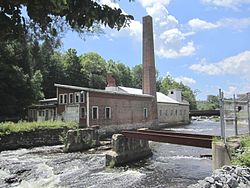| Kayaderosseras Creek | |
|---|---|
 Kayaderosseras Creek looking downstream from US Route 9, April 2012 | |
 | |
| Location | |
| Country | United States |
| State | New York |
| Region | Upstate New York |
| Metropolitan area | Capital District |
| Counties | Saratoga County |
| Physical characteristics | |
| Source | |
| • location | Corinth, Saratoga County, New York |
| • coordinates | 43°12′00″N73°55′17″W / 43.20000°N 73.92139°W [1] |
| • elevation | 1,400 ft (430 m) |
| Mouth | Saratoga Lake |
• location | Saratoga Springs/Malta, Saratoga County, New York |
• coordinates | 43°02′27″N73°44′14″W / 43.04083°N 73.73722°W [1] |
• elevation | 200 ft (61 m) |
| Basin size | 195 sq mi (510 km2) |
| Basin features | |
| River system | Hudson River Watershed |
| Tributaries | |
| • left | Mud Creek, Vly Creek, Star Brook, Geyser Brook, Bog Meadow Brook |
| • right | South Branch Kayaderosseras, Crook Brook, Glowgee Creek, Gordon Creek, Mourning Kill |
The Kayaderosseras Creek, usually shortened to Kaydeross, is the largest river that lies completely within Saratoga County, New York State. It originates in the Kayaderosseras Range in the northern part of the county, passes through the towns of Corinth, Greenfield, and Milton, and serves as the boundary between the City of Saratoga Springs and the Town of Malta before emptying into Saratoga Lake.








